How to Hit a Fade in Golf: A Simple Guide for Golfers
Posted by
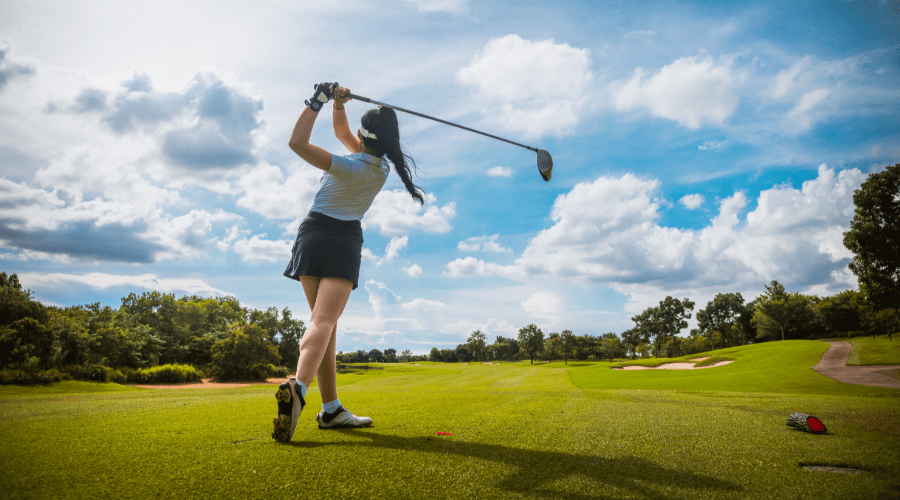
You’ve probably watched countless pros shape their shots effortlessly every time, sending the ball from left to right with total control. Annoying, right?
A fade is one of those shots that looks impressive—but the good news is, it’s not all just natural ability. It’s totally within your reach.
It all comes down to getting the right setup, understanding club face angles, and staying consistent with your swing path.
When everything lines up, there’s nothing more satisfying than watching the golf ball curve back toward your target. This guide will walk you through the basics of hitting a reliable fade—one that can add serious versatility to your game.
What Is a Fade in Golf?

A fade is one of the most useful shots in golf—a controlled left-to-right ball flight for right-handed golfers (or right to left for the lefties).
Instead of a sharp curve like a slice, a fade starts slightly left of your target and gently works its way back. It’s a great shot shape for keeping the ball in play, especially on tight fairways or when there’s trouble on one side.
By using a controlled fade, you can aim away from hazards and trust the ball to curve safely back toward your target.
The best part? A fade isn’t about swinging harder—it’s all about setup and positioning. A slightly open stance, combined with a clubface that’s pointed near your target, naturally encourages an out-to-in club path that creates the desired spin.
Some golfers think of a fade as a more controlled version of a golf slice, but instead of the ball veering wildly off course, you’re in charge of the movement.
And compared to a draw, a fade can be easier to manage since it tends to land softer and take a friendlier bounce.
A fade can be a real game-saver when the fairways feel tight, or the wind is unpredictable. It’s also a great tool for approach shots, especially when the pin is tucked behind a hazard on the left.
With a reliable fade, you can send the ball on a safe line, watch it drift toward the hole, and feel that extra confidence in your game.
Why Learn to Hit a Fade?

Shaping the ball from left to right might seem tricky at first, but once you get the hang of it, a fade can give you a whole new level of control over your shots.
If you’ve ever faced a fairway with a bunker or an out-of-bounds fence on the left side, you know how useful it is to have a shot that gently drifts back toward the center. A fade can be a game-changer on narrow holes where there’s little room for error.
Even some of the best players in the world rely on it as their go-to shot because it tends to be more controlled and less likely to turn into a disastrous hook.
Beyond strategy, learning to hit a fade can also boost your confidence. Knowing that your ball isn’t likely to curve hard left can take the pressure off and help you swing more freely.
This shot shape type also comes in handy on approach shots, landing softer and making it easier to hold the green instead of rolling off the back.
Plus, on windy days, a fade’s higher flight can be an advantage, keeping the ball more stable in the air without exaggerated sideways movement.
How Hitting Fades Can Help Your Game
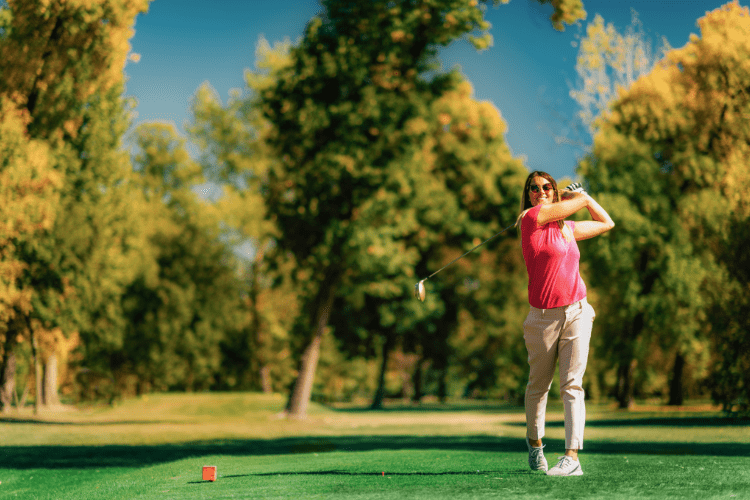
If you’ve ever struggled with hooks or unpredictable ball flights, a fade can be a game-changer. Literally.
By setting up with a slightly open stance and creating a left-to-right shot shape, you naturally reduce the chances of those big, frustrating curves that send your ball into trouble.
Here’s why a fade can be a valuable tool in your game:
- More Control & Fewer Mistakes: A fade helps eliminate severe hooks and keeps the ball in play, reducing penalty strokes.
- Stops Faster on Greens: The slightly higher flight of a fade means it lands softer, making it easier to hold firm greens and attack tucked pins.
- Predictable Ball Flight: A well-struck fade starts left and moves right in a controlled way, helping you plan shots with more confidence.
- Safer Off the Tee: If trouble is waiting on the left, a fade naturally moves away from that danger, keeping your drives in play.
- Reliable Under Pressure: Unlike a slight draw, which relies on precise timing, a fade is more about controlled positioning—making it easier to execute consistently.
- Favored by Pros for a Reason: Many professionals prefer a fade because it’s reliable and helps avoid costly mistakes.
Whether you’re looking for safer tee shots or more precise approaches, dialing in a fade can give you more confidence and control over your game.
How to Hit a Fade
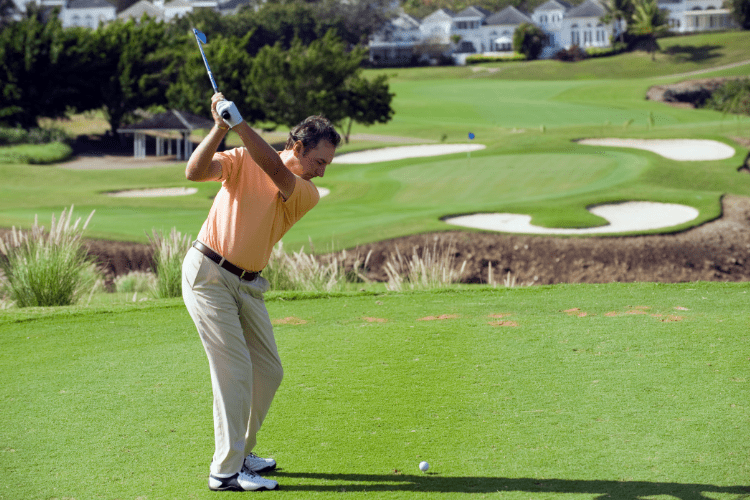
A fade might seem tricky at first, but once you get the basics down, it becomes a reliable shot shape you can trust. It all comes down to setup, clubface control, and the right swing path.
Here’s how to make it happen:
Align your stance to the left: Align feet and shoulders slightly left of your target. This setup helps promote an out-to-in swing path, which is key for creating a fade. Think of it as giving your ball room to start left and gently curve back toward the middle.
Adjust your grip for control: Keep your grip neutral—don’t twist your hands too much in either direction. A slightly open clubface at impact helps create that controlled left-to-right movement you’re looking for. A solid, balanced grip also improves consistency and makes for clean contact.
Position the ball correctly: Place the ball just inside your left heel (for right-handed players). This position helps you make contact slightly on the upswing, adding just the right amount of spin.
If the ball is too far back, your shot might come out low and awkward. Place the ball slightly forward, and your timing could suffer.
Swing on an out-to-in path: Picture your club traveling across the ball, following your toe line. Let your torso rotation lead the movement—this keeps the clubface open at impact. Avoid flipping your wrists too soon; that’s what keeps the fade smooth and controlled.
The key is to practice these steps consistently so they feel natural. Once you dial in your fade, you’ll have a shot shape you can rely on—whether it’s keeping the ball in play off the tee or shaping an approach shot around trouble.
Training Aids for Mastering the Fade
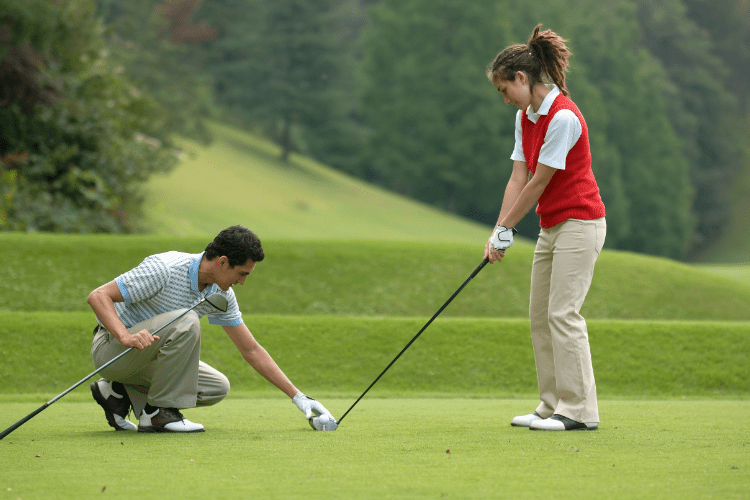
Training aids are a great way to refine your fade and speed up your progress. Alignment sticks are a top choice; place one along your target line and another for your foot placement to avoid a closed stance and pulled shots.
You can also use a gate of tees to guide your clubhead across the ball at the right angle.
Impact tape or foot spray shows where you’re hitting the clubface. If the marks land on the toe or heel, adjust your stance or swing path. Recording your swing and comparing it to the impact marks can also help identify misalignments.
Weighted clubs or resistance bands are excellent for building core strength, which supports a stable golf swing. A mirror or video analysis can provide instant feedback on your posture and alignment.
Plus, for personalized tips and expert golf coaching, Skillest is here to help you improve your fade and elevate your game.
Common Mistakes (and How to Avoid Them)
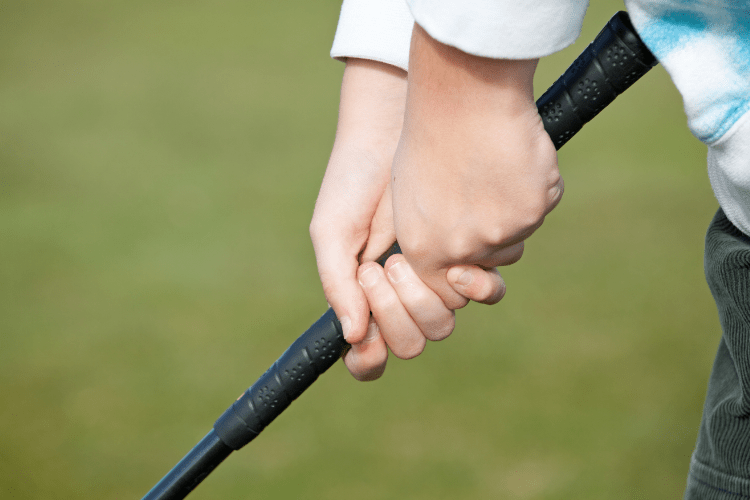
A fade is a great shot to have in your arsenal, but it’s easy to make a few missteps along the way. If you’re pulling the ball far left or slicing it, here are some things to watch out for:
Incorrect clubface alignment: It’s tempting to set up with an open stance, but if your clubface is also pointed left of the target, you’re setting yourself up for a pull with no chance of a fade. Make sure the clubface stays slightly open—just enough to encourage the right-to-left spin without going too far left.
Gripping too tightly: Tension is a big enemy when it comes to golf. If your grip is too tight, you might find yourself forcing the wrists, which can close the clubface and mess with your timing. But you don’t want a weak grip either. Keep your grip relaxed and steady for a smoother, more controlled shot.
Alignment issues: Sometimes, the shoulders and feet don’t line up correctly, which can throw off your normal swing path. This makes it tough to consistently hit that fade. Double-check your alignment before each shot to ensure everything’s pointing in the right direction.
Incorrect ball position: If you position the ball too far back or too far forward in your stance, it can throw off your swing’s angle of attack. Aim for a spot near your left heel (for right-handed players) to get that sweet, slightly upswing contact.
Swinging too hard: Trying to hit a big fade by swinging out of your shoes is a surefire way to mess things up. A smooth, controlled swing will do the trick. Let the fade happen naturally without forcing it, and focus on accuracy over power.
Over-the-top motion: If you’ve been swinging wildly over the top, it’s time to dial it back. A fade works best when you swing from outside to inside, not chopping down on the ball. Keep the path gentle for a more reliable shot.
A rushed or unbalanced follow-through: A balanced finish is a great indicator of a well-executed fade. If your body is out of sync at the end of your swing, you’re more likely to end up with a wild shot. Keep things smooth and controlled through the follow-through.
If you’re looking to take your fade (and your game) to the next level, Skillest can help you refine your technique with personalized feedback from golf lessons.
Mastering the Fade with Confidence
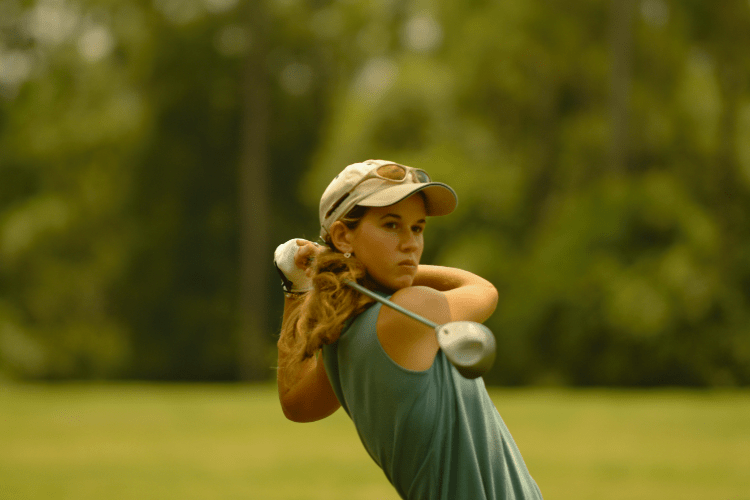
Mastering a reliable fade may seem tricky at first, but it all comes down to a few simple steps. An open stance, ball near your left heel, and a smooth swing from outside to inside are key.
The fade isn’t just for advanced players—it’s a great way to improve accuracy and stay calm on the golf course. Once you see that gentle left-to-right curve, it’ll feel like you’ve unlocked a new level of shot-making.
By practicing these fundamentals consistently, you’ll gain confidence, whether you’re hitting tee shots or iron approaches. You don’t need to chase power.
A fade is about keeping the clubface open and trusting your setup. Small adjustments will come over time, and soon enough, the fade will feel natural—offering you control and predictability.
If you’re looking for personalized help, Skillest is a great resource. Online golf lessons can quickly pinpoint any issues, like a grip that’s too tight or a stance that’s too closed.
With a coach’s guidance, you’ll turn your fade into a dependable shot from tee to green. With some dedication, you’ll have a winning fade in no time!
Frequently Asked Questions (FAQ):
How does a golfer hit a fade shot in golf?
Position the stance slightly left of the target, keep the clubface near the target line, and swing along the body line. This approach encourages the gentle left-to-right spin often associated with a slight fade.
How far left should a golfer aim for a fade?
That depends on the desired curve. Many prefer aiming a few yards left of center. Once the fade starts taking shape, a golfer can tweak aim to find the exact spot that allows a comfortable curve into the fairway or green.
What creates a fade in golf?
An out-to-in path, combined with a slightly open face at impact, produces the sidespin that bends the ball from left to right.
How can a golfer hit a fade without coming over the top?
It’s important to maintain a smooth shoulder turn and refrain from slamming the club downward. Allow the clubface to stay open through impact, and keep the motion balanced. This helps avoid an extreme, over-the-top move that results in a slice or pull.
